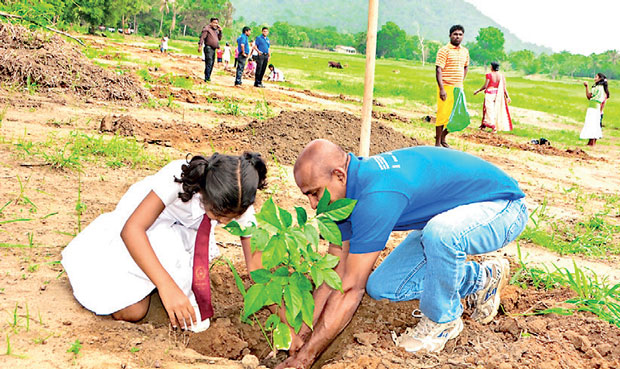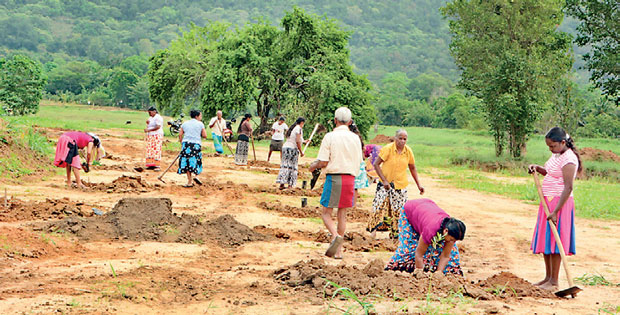29 Dec 2016 - {{hitsCtrl.values.hits}}


The surroundings of the Podiwewa, a minor irrigation tank in Monaragala was a hive of activity recently as the villagers from Thimbirigas-ara in Buttala came together with a single intention in mind.
The villagers, both young and old joined the Monaragala District Secretary D.S. Pathmakulasooriya and officials from the Department of Agrarian Developmentto plant saplings around the Podiwewa in a bid to develop the tank ecosystem. The Podiwewa is intertwined with the lives of 43 farmer families in Thimbirigas-ara as it irrigates paddy farms and Other Field Crop cultivations while also providing a water source for daily needs. Supported by the Food and Agriculture Organization of the United Nations (FAO) and the European Union, saplings such as Kumbuk, Tamarind, Mee and Karandawere planted on the upstream section of the tank. Palmyra saplings were planted along the downstream edgeof the tank bund.
“The saplings were provided by our villagers and theForest Department” said Mr. Gunadasa who is the President of the Thimbirigas-ara FarmersOrganization. “We planted around 600 saplings in a one kilometer area.Each farmer has now taken on the responsibility of nurturing around 10-15 of these plants.” The saplings that were planted in the upstream section of the tank (gasgommana) will eventually become natural wind barriers during high winds, reduce evaporation and erosion, and will protect the tank from illegal encroachments.
In Sri Lanka, the ecological segments of the village tank system play vital roles. The downstream reservation (kattakaduwa) is the stretch between the tank bund and paddy fields. It contains flora which acts as a downstream wind barrier, minimizes seepage and prevents polluted water containing salt and heavy metals from flowing into paddy fields. The soil ridge (iswetiya) of the tank diverts sediments/silt, thereby preventing soil erosion. The waterhole (godawala) in the tank inlets act as a source of drinking water for wildlife and livestock while trapping the sediments, which would otherwise flow into the tank. However most of theecological components of village tanks that have existed for centuries are disappearing. Encroachment for cultivation purposesand removal of trees for various uses are some of the main reasons. The cause stems from a lack of awareness on the importance of the tank ecosystem.
FAO Technical Officer (Monaragala District), Ranjith Pushpananda said, “Developing the ecosystem of irrigation tanks is crucial as tanks mitigate the effects of natural disasters such as drought and floods. For instance, the storage of excessive runoff water in tanks during heavy rains reducesflooding and the conservation of water for use in the dry season. Irrigation tanks also enhance the biodiversity. The importance of the tank ecosystem was shared with the villagers of Thimbirigas-ara. The villagers constructed the soil ridge of the tank and the waterhole prior to the tree planting initiative.”
The Podiwewa is currently being rehabilitated by FAO under the European Union Support to District Development Programme (EU-SDDP) which has a total financial envelope of EUR 60 million. Improvements to the irrigation channel and spillway of the Podiwewa, widening of the tank bund and improving the access road to the tank are ongoing. Once rehabilitation works are completed, the farmers of Thimbirigas-ara will conduct regular ordinary maintenance of the tank and will continue to conserve the tank ecosystem.
Gunadasa echoed “We became aware of how the environment helps us and the importance of protecting the tank and its surroundings. At a time when trees are being cut down and forests are being cleared, planting saplings on the tank bed of the Podiwewa is an example to villagers that depend on tanks. The future generation of Buttala will greatly benefit from it.”
10 Jan 2025 23 minute ago
10 Jan 2025 1 hours ago
10 Jan 2025 2 hours ago
10 Jan 2025 4 hours ago
10 Jan 2025 4 hours ago